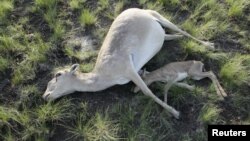ALMATY -- Still looking for answers to what killed nearly one-third of the world's critically endangered saiga antelope population in recent weeks, scientists and activists in Kazakhstan are calling on the authorities to allow outsiders to help in the investigation.
During a June 1 press conference in Almaty, the country's Prosecutor-General's Office and the Agriculture Ministry were asked to send samples of the dead animals as well as local soil and water samples to forensic labs abroad.
The group -- which included writer Marat Toqashbaev and Kazakh Writers' Union Secretary Maraltai Raimbekuly -- also demanded that seven activists be included on the state commission investigating the mass saiga deaths.
The calls came the same day that Kazakhstan's Agriculture Ministry provided a new death count, estimating that 127,000 saiga have died in recent weeks.
Kazakhstan is a primary habitat for the unique antelope, whose ancestors survived the Ice Age and once roamed vast areas of the Eurasian steppe and parts of North America. The antelope, known for their distinctive tubular snout and prized spiraled horns, can be found today only in Kazakhstan, Russia's Kalmykia Republic, and Mongolia.
Its numbers, once in the millions, were severely depleted after the fall of the Soviet Union when hunters and poachers killed the animals in large numbers for its meat and horns, which are used in Chinese medicine. The saiga, which survived near extermination in the 1920s, rebounded to the extent that their horns were once proposed by conservationists as an alternative to the horn of the world's dwindling rhinoceros population.
Prior to the recent mass deaths, Kazakhstan's saiga population had increased from some 21,000 in 2003 to over 250,000, accounting for the vast majority of the animals' global population.
Toxic Fuel Or Infection?
Activists in Kazakhstan have suggested that Russia's Proton-M rocket launches from the Baikonur Cosmodrome in central Kazakhstan could be responsible for the saiga deaths. Several of the rockets, which carry a highly toxic fuel, have failed during launch in recent years. The most recent incident occurred in May, and a joint Russian-Kazakh investigation has determined that the rocket shut down over the region of Russia's Lake Baikal and its contents burned up in the atmosphere.
Last week, Kazakhstan's Space Agency deputy chief Meirbek Moldabekov said he did not rule out that the mass death of saiga might be linked to Baikonur Cosmodrome, but added that officials do not see a "direct link" between the animals' die-off and the space complex's operations.
Kazakh authorities suggested earlier that the saiga deaths might have been caused by the bacterial infection pasteurellosis. In 2012, when nearly 1,000 dead saigas were discovered, the authorities named pasteurellosis as the possible cause, although the diagnosis was never confirmed.
At the time, activists pointed to the Proton-M rocket launches as a possible cause.












